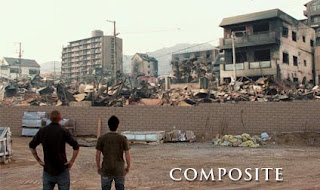If you wanted your actors to be seen standing in front of the Imperial Palace on the
planet Mungo, you may not want to spend the money to build the exterior of
the entire Imperial Palace.
Better to build a small piece of it on a movie set, place the
talent in it, then extend the set later using CGI when you need a wide shot. For this
little piece of digital magic, the fi lm is digitized into the computer and the CGI folks
build a 3D model of the Imperial Palace and line it up with the original fi lm footage
and its camera angle.
There might even be a camera move in the live action that the
CGI artists will carefully track and match; but eventually, the live action and the CGI
set extension must be composited and color corrected to match perfectly.
Figure 1-2 is a classic example of a set extension that demonstrates how they can
even be applied to an exterior location shot. The original photography captures the
future soldier walking along an otherwise small and uninteresting rubble pit. The
middle picture shows the set extension element that was an all CGI city in the distance
with smoke generated by a particle system and a matte painting for the sky.
The resulting composite shows all of the elements composited together and color
corrected to blend properly.
You can immediately see the enormous difficulty in trying to create this shot
without using set extension and digital composting. You would need to fi nd a location that had the rubble pit the correct distance from a real city that had the right
look and was (unhappily) on fi re at the time. You would then have to wait for the
right time of day to get the sunset sky, and in location shooting, waiting is very
expensive. If such a location could even be found, you would then have to fl y the
entire crew out there. This amounts to a very expensive if not nearly impossible
production plan.
Instead, the producer wisely chose to do a set extension. The rubble pit was easy
to find and close at hand. The crew drove to the location in only half an hour. Once
the film was digitized, the CGI department took over and created the background
city and smoke animation, while the digital matte painter made the sky painting.
When all was ready, the digital compositor took all four elements: Original photography,
CGI set extension, smoke animation, and matte painting, and then composited
them together and then color-corrected them to blend naturally. Not only was
this far less expensive, but (and this is the punch line) the director got exactly the
shot he wanted. What CGI and digital compositing bring to the table is creative
control—the ability to make exactly the shot you want—not just what is practical
or affordable.
Sunday, June 5, 2011
Subscribe to:
Post Comments (Atom)









No comments:
Post a Comment